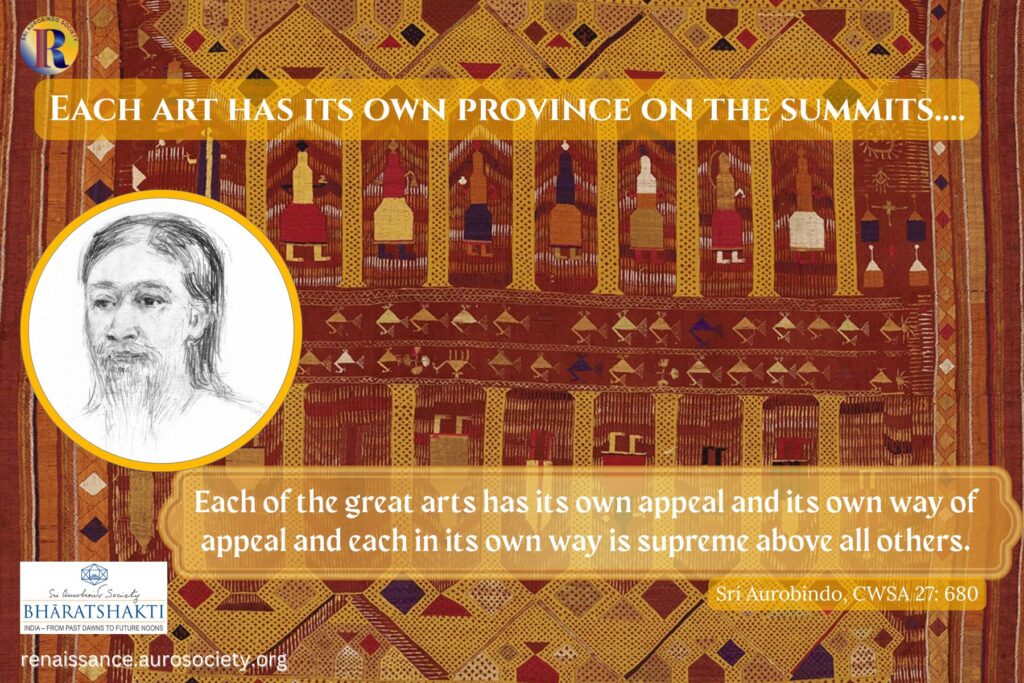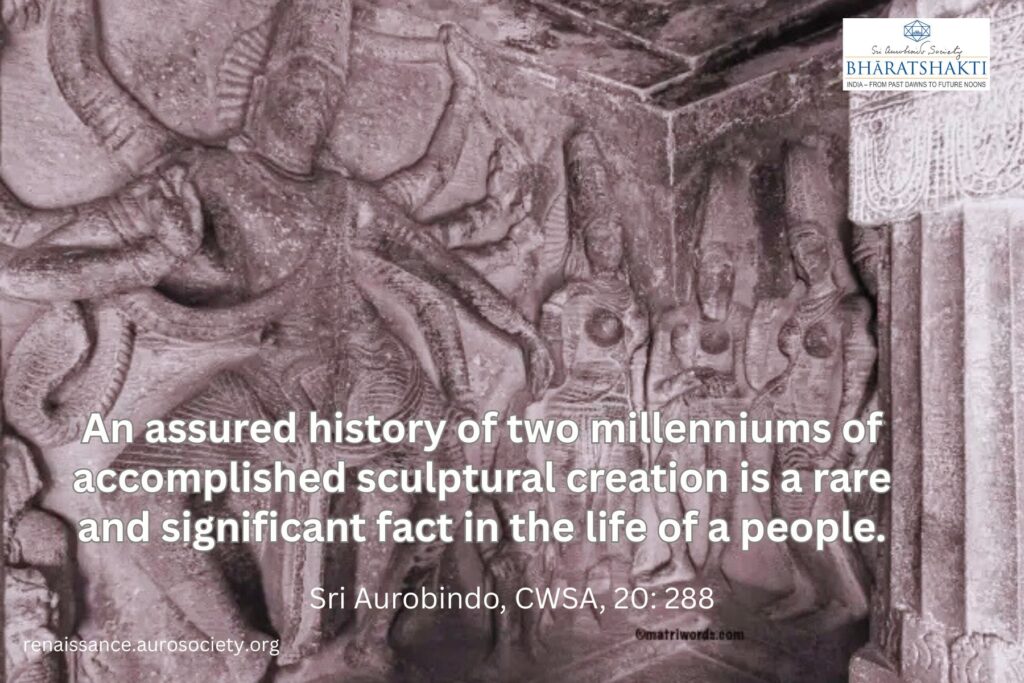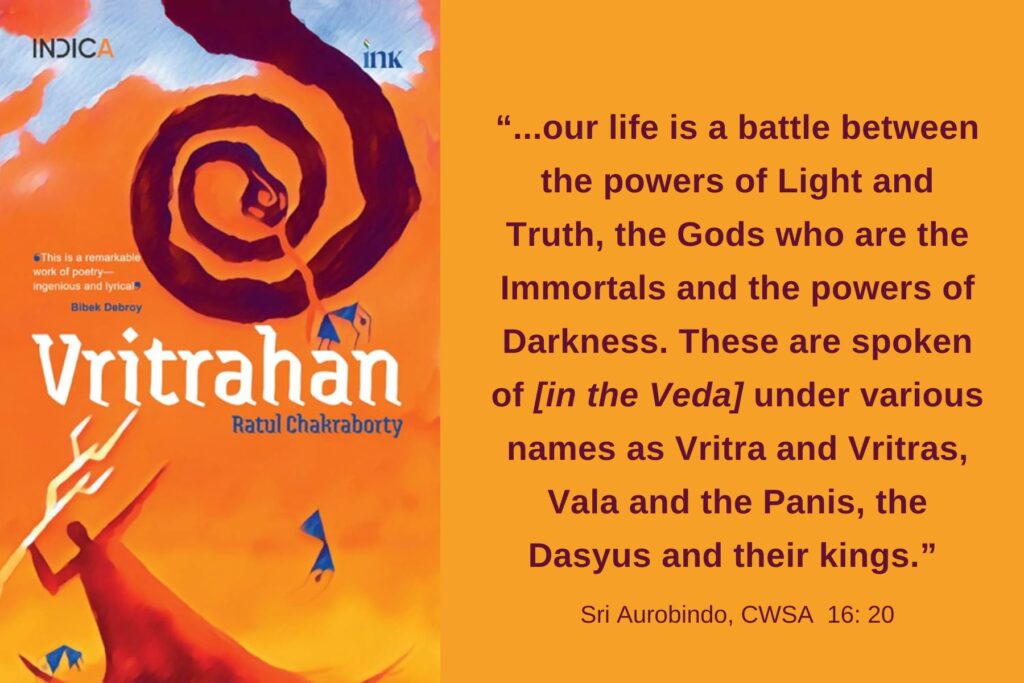Volume V, Issue 1
Author: Nolini Kanta Gupta
Editor’s note: The following passages are excerpted from Volume 2 of Collected Works of Nolini Kanta Gupta (pp. 12-35). The original essay titled ‘Upanishadic Symbolism’ takes up several important references and explains their symbolism. But for our purpose here, we have chosen only three – about the Five Elements, Triple Agni and Number of Gods.
We have made a few minor formatting changes for the purpose of this digital presentation.
The Upanishads have always been recognised in India as the crown and end of Veda; that is indicated in their general name, Vedanta.
~ Sri Aurobindo, CWSA, Vol. 20, p. 203

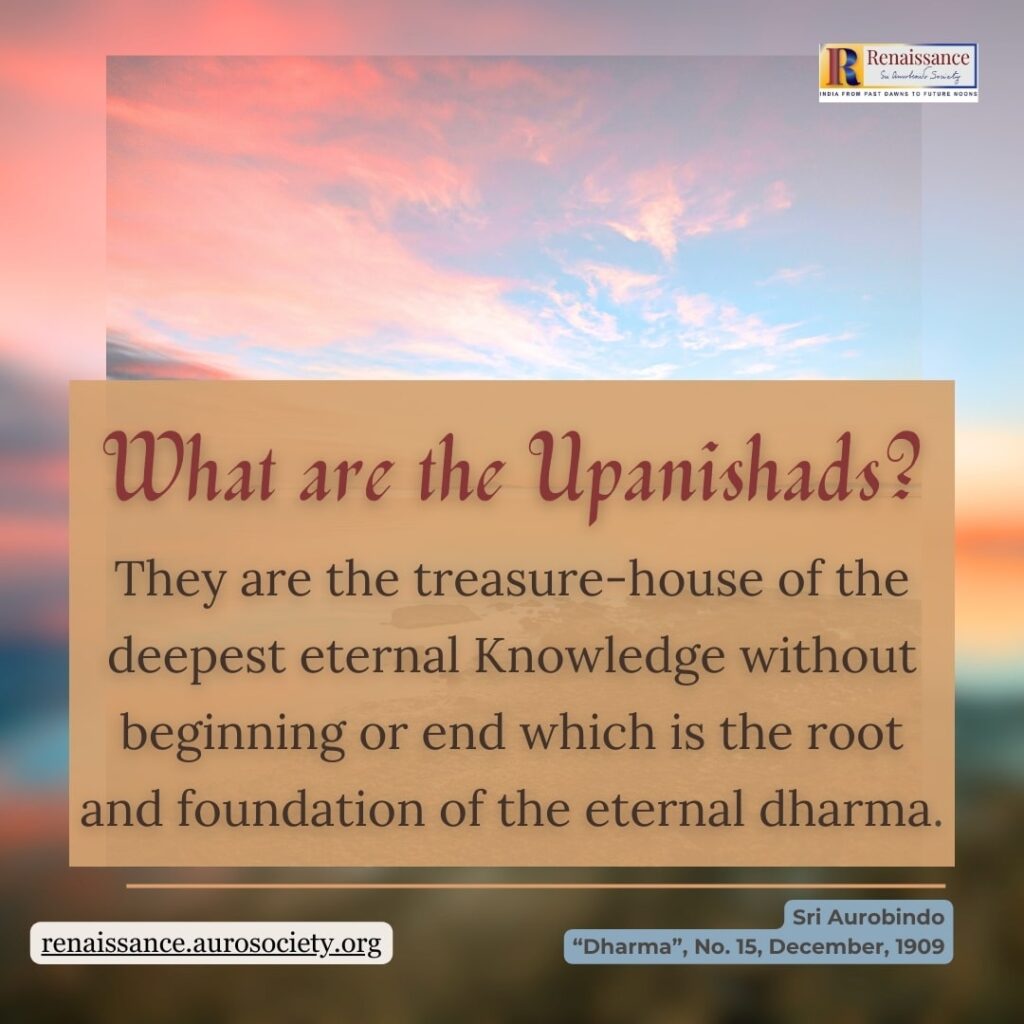
* * *
A certain rationalistic critic divides the Upanishadic symbols into three categories—those that are rational and can be easily understood by the mind; those that are not understood by the mind and yet do not go against reason, having nothing inherently irrational in them and may be simply called non-rational; those that seem to be quite irrational, for they go frankly against all canons of logic and common sense.
As an example of the last, the irrational type, the critic cites a story from the Chhāndogya, which may be rendered thus:
There was an aspirant, a student who was seeking after knowledge. One day there appeared to him a white dog. Soon, other dogs followed and addressed their predecessor: “O Lord, sing to our Food, for we desire to eat.”
The white dog answered, “Come to me at dawn here in this very place.” The aspirant waited. The dogs, like singer-priests, circled round in a ring. Then they sat and cried aloud; they cried out, “Om We eat and Om we drink, may the gods bring here our food.”
* * *
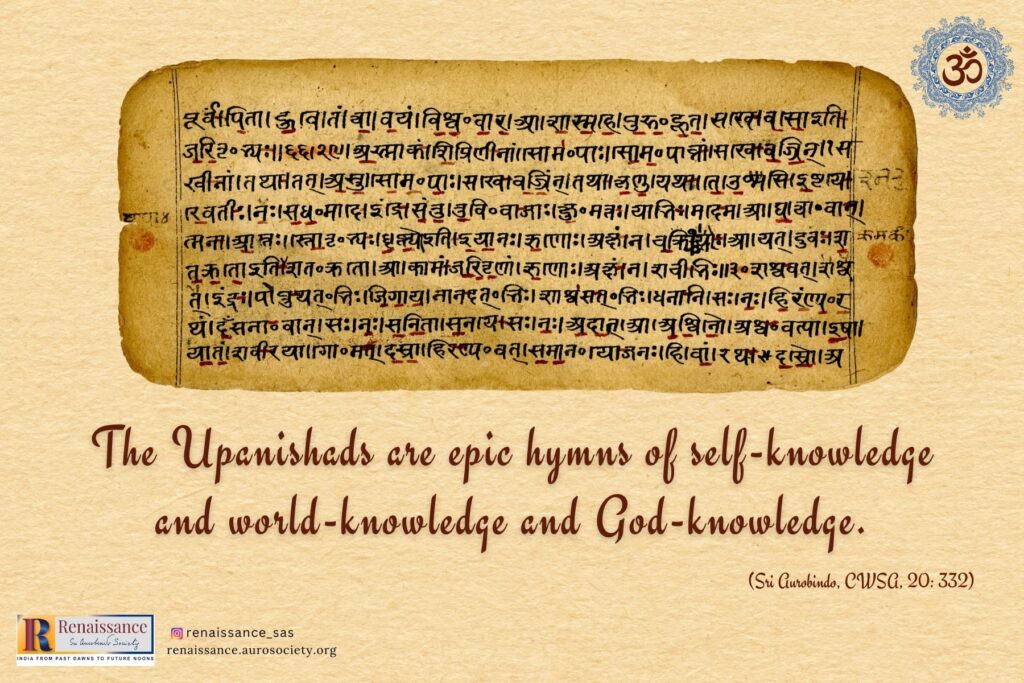
Now, before any explanation is attempted it is important to bear in mind that the Upanishads speak of things experienced—not merely thought, reasoned or argued. And that these experiences belong to a world and consciousness other than that of the mind and the senses. One should naturally expect here a different language and mode of expression than that which is appropriate to mental and physical things.
For example, the world of dreams was once supposed to be a sheer chaos, a mass of meaningless confusion. But now it is held to be quite otherwise. Psychological scientists have discovered a method—even a very well-defined and strict method—in the madness of that domain. It is an ordered, organised, significant world. But its terminology has to be understood, its code deciphered. It is not a jargon, but a foreign language that must be learnt and mastered.
In the same way, the world of spiritual experiences is also something methodical, well-organized, significant. It may not be and is not the rational world of the mind and the sense. But it need not, for that reason, be devoid of meaning, mere fancifulness or a child’s imagination running riot. Here also the right key has to be found, the grammar and vocabulary of that language mastered…
Now, as regards the interpretation of the story cited, should not a suspicion arise naturally at the very outset that the dog of the story is not a dog but represents something else? First, a significant epithet is given to it—white. Secondly, although it asks for food, it says that Om is its food and Om is its drink.
In the Vedas we have some references to dogs.
Yama has twin dogs that “guard the path and have powerful vision”. They are his messengers, “they move widely and delight in power and possess the vast strength”. The Vedic Rishis pray to them for Power and Bliss and for the vision of the Sun (Rig Veda, X. 14-11, 12). There is also the Hound of Heaven, Sarama, who comes down and discovers the luminous cows stolen and hidden by the Panis in their dark caves. She is the path-finder for Indra, the deliverer.
My suggestion is that the dog is a symbol of the keen sight of Intuition, the unfailing perception of direct knowledge. With this clue the Upanishadic story becomes quite sensible and clear and not mere abracadabra.
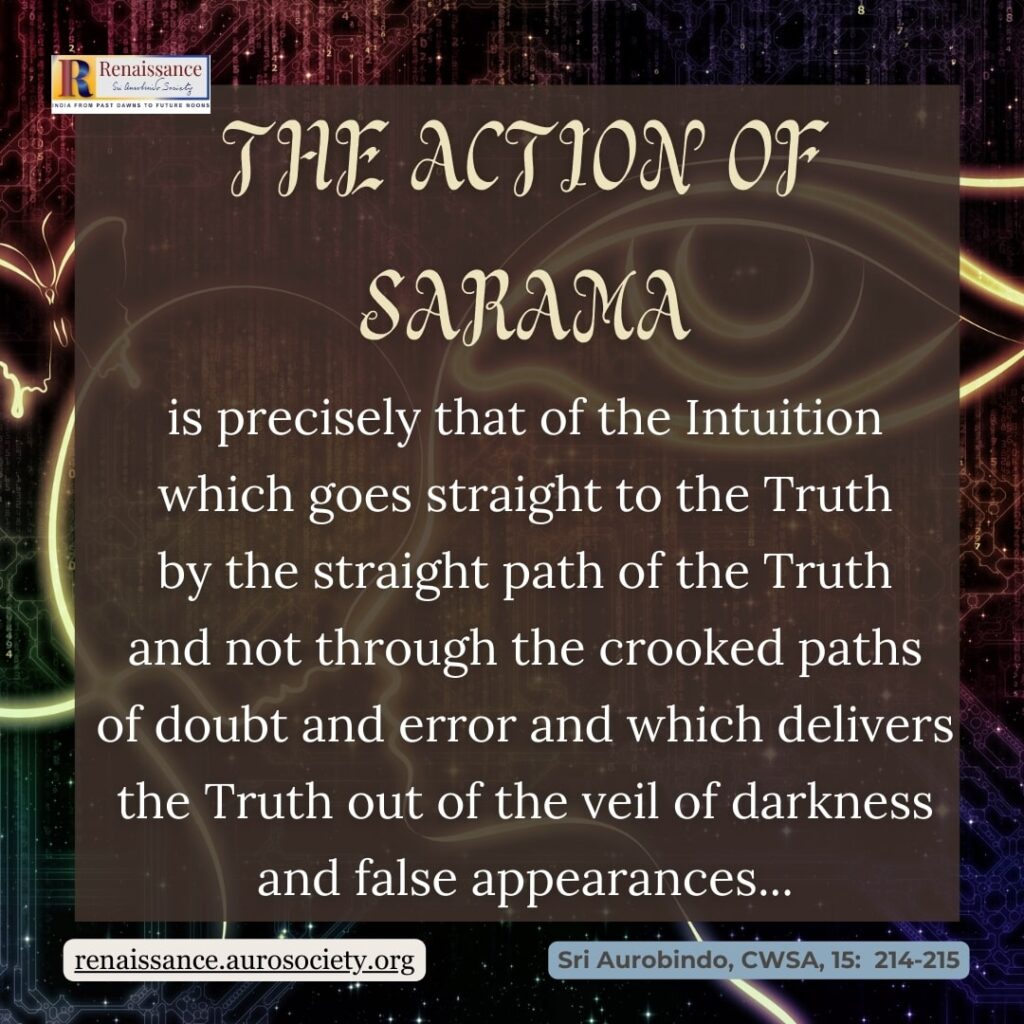
To the aspirant for Knowledge came first a purified power of direct understanding, an Intuition of fundamental value. And this brought others of the same species in its train. They were all linked together organically—that is the significance of the circle, and formed a rhythmic utterance and expression of the supreme truth (Om). It is also to be noted that they came and met at dawn to chant, the Truth. Dawn is the opening and awakening of the consciousness to truths that come from above and beyond.
It may be asked why the dog has been chosen as the symbol of Intuition.
In the Vedas, the cow and the horse also play a large part; even the donkey and the frog have their own assigned roles. These objects are taken from the environment of ordinary life. They are those that are most familiar to the external consciousness, through which the inner experiences have to express themselves, if they are to be expressed at all.
These material objects represent various kinds of forces and movements and subtle and occult and spiritual dynamisms. Strictly speaking, however, symbols are not chosen in a subtle or spiritual experience, that is to say, they are not arbitrarily selected and constructed by the conscious intelligence. They form part of a dramatization (to use a term of the Freudian psychology of dreams), a psychological alchemy, whose method and process and rationale are very obscure, which can be penetrated only by the vision of a third eye.
Click HERE to read about the Triple Agni in the Upanishads.
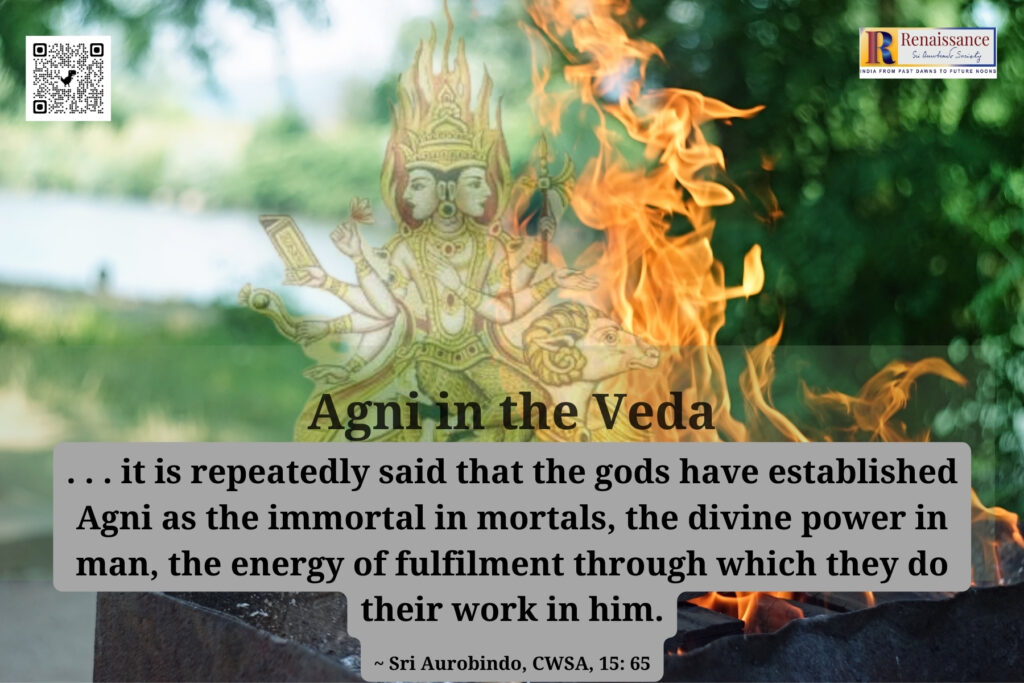
The Five Great Elements
The five elements of the ancients—earth, water, fire, air and ether or space—are symbols taken from the physical world to represent other worlds that are in it and behind it. Each one is a principle that constitutes the fundamental nature of a particular plane of existence.
Earth represents the material world itself, Matter or existence in its most concrete, its grossest form. It is the basis of existence, the world that supports other worlds (dharā, dharitri), the first or the lowest of the several ranges of creation. In man it is his body. The principle here is that of stability, substantiality, firmness, consistency.
Water represents the next rung—the vital world, the world life-force (prāṇa).
Physiologically also we know that water is the element forming three-fourths of the constituents of a living body. And that dead and dry are synonymous terms; it is the medium in which the living cells dwell and through which they draw their sustenance. Water is the veritable sap of life—it is the emblem of life itself. The principle it represents is that of movement, continuity, perpetuity.
Fire represents the Heart.
It is that which gives the inner motive to the forces of life. It is the secret inspiration and aspiration that drive the movements of life. Fire is the heat of consciousness, the ardour of our central being that lives in the Truth and accepts nothing, nothing but the Truth. It is the pure and primal energy of our divine essence, driving ever upward and onward life’s course of evolution.
Air is Mind, the world of thought, of conscious formation.
It is where life-movements are taken up and given a shape or articulate formula for an organised expression. The forms here have not, however, the concrete rigidity of Matter, but are pliant and variable and fluid. In fact, they are more in the nature of possibilities, rather than actualities. The Vedic Maruts are thought-gods, and lndra (the Luminous Mind), their king, is called the Fashioner of perfect forms.
Ether or Space is the infinitude of the Spirit, the limitless Presence that dwells in and yet transcends the body, the life the heart and the mind.
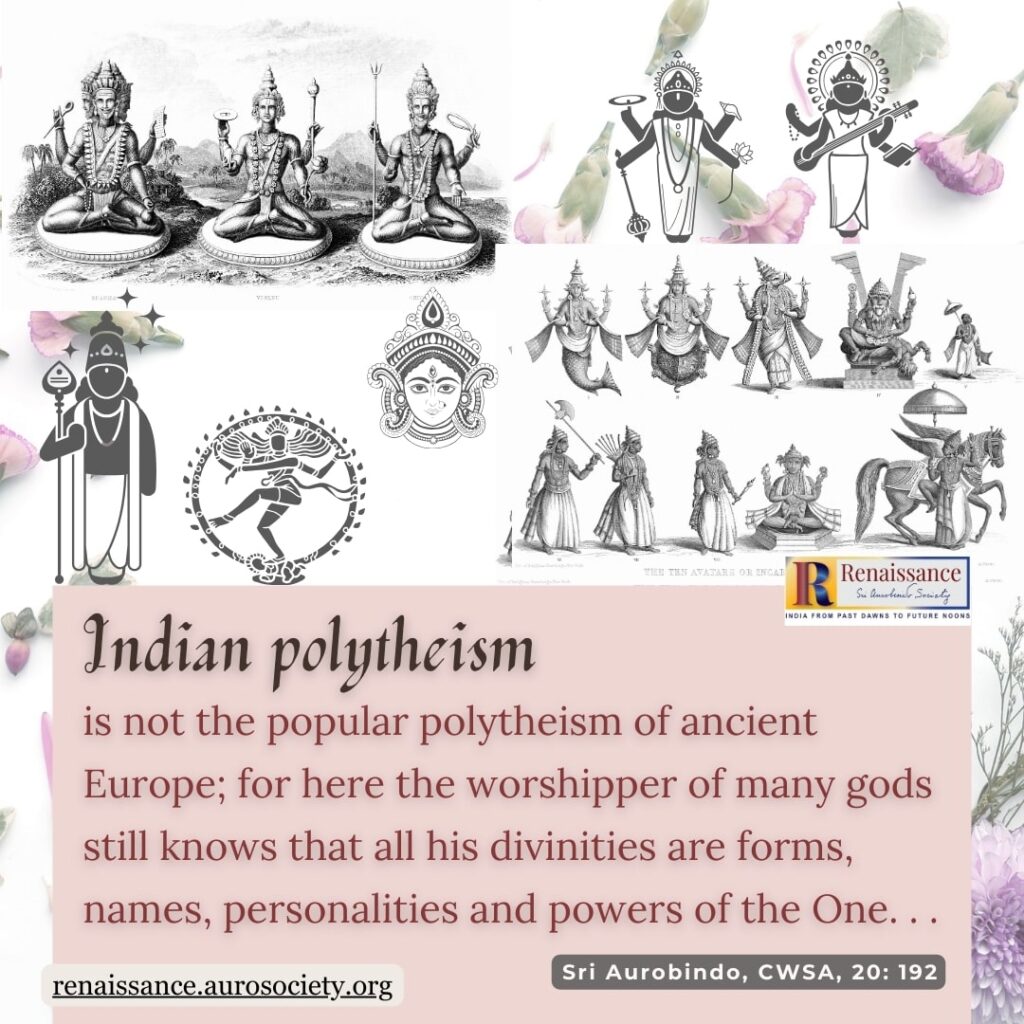
How Many Gods?
“How many Gods are there?” Yajnavalkya was once asked (Brihadaranyaka III.9). The Rishi answered, they say there are three thousand and three of them, or three hundred and three, or again, thirty-three; it may be said too there are six or three or two or one and a half or one finally. Indeed as the Upanishad says elsewhere, it is the One Unique who wished to be many: and all the gods are the various glories (mahimā) or emanations of the One Divine. The ancient of ancient Rishis had declared long long ago, in the earliest Veda, that there is one indivisible Reality, the seers name it in various ways.
In Yajnavalkya’s enumeration, however, it is to be noted, first of all, that he stresses on the number three.
The principle of triplicity is of very wide application. It permeates all fields of consciousness and is evidently based upon a fundamental fact of reality. It seems to embody a truth of synthesis and comprehension. Also, it points to the order and harmony that reigns in the cosmos, the spheric music.
The metaphysical, that is to say, the original principles that constitute existence are the well-known triplets: (i) the superior: Sat, Chit, Ananda; and (ii) the inferior: Body, Life and Mind—this being a reflection or translation or concretisation of the former.
We can see also here how the dual principle comes in, the twin godhead or the two gods to which Yajnavalkya refers.
The same principle is found in the conception of Ardhanarishwara, Male and Female, Purusha-Prakriti. The Upanishad says (Brihadaranyaka I.4) yet again that the One original Purusha was not pleased at being alone, so for a companion he created out of himself the original Female. The dual principle signifies creation, the manifesting activity of the Reality.
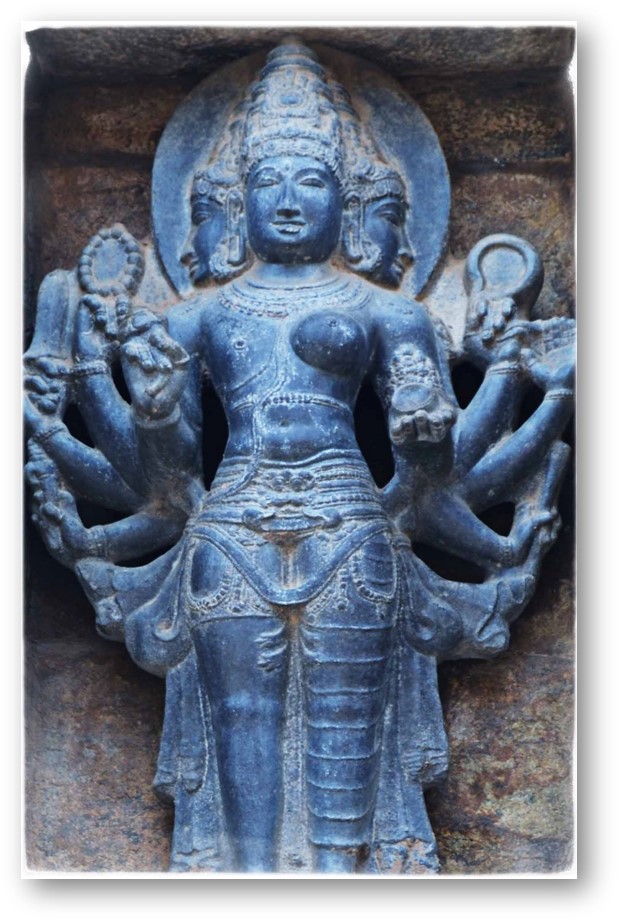
But what is this one and a half to which Yajnavalkya refers? It simply means that the other created out of the one is not a wholly separate, independent entity: it is not an integer by itself, as in the Manichean system, but that it is a portion, a fraction of the One.
And in the end, in the ultimate analysis, or rather synthesis, there is but one single undivided and indivisible unity.
The thousands and hundreds, very often mentioned also in the Rig Veda, are not simply multiplications of the One, a graphic description of its many-sidedness. It indicates also the absolute fullness, the complete completeness (pūrṇasya pūrṇam) of the Reality. It includes and comprehends all and is a rounded totality, a full circle.
The hundred-gated and the thousand-pillared cities of which the ancient Rishis chanted are formations and embodiments of consciousness human and divine. They are realities whole and entire englobing all the layers and grades of consciousness.
Besides this metaphysics there is also an occult aspect in numerology of which Pythagoras was a well-known adept and in which the Vedic Rishis too seem to take special delight.
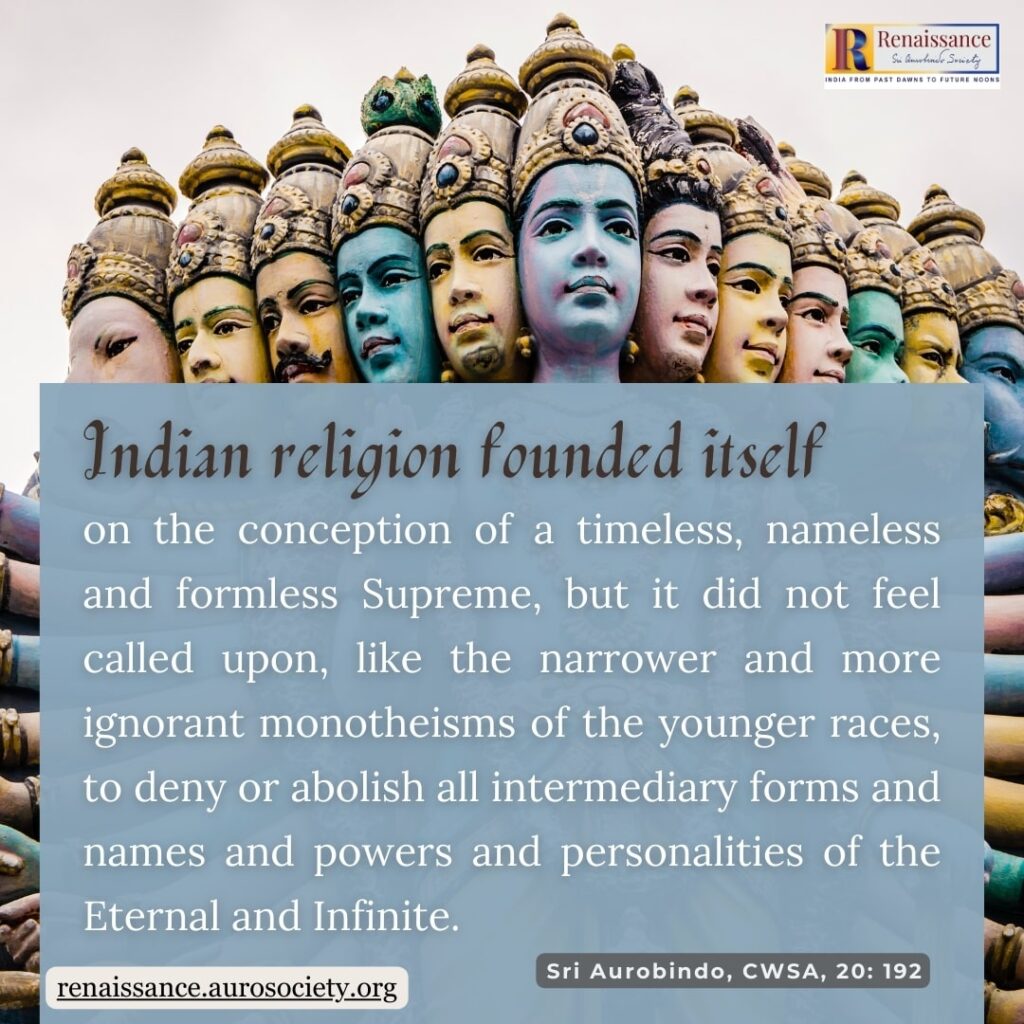
The multiplication of numbers represents in a general way the principle of emanation.
The One has divided and subdivided itself, but not in a haphazard way. It is not like the chaotic pulverisation of a piece of stone by hammer-blows. The process of division and subdivision follows a pattern almost as neat and methodical as a genealogical tree. That is to say, the emanations form a hierarchy.
At the top, the apex of the pyramid, stands the one supreme Godhead. That Godhead is biune in respect of manifestation—the Divine and his creative Power. This two-in-one reality may be considered, according to one view of creation, as dividing into three forms or aspects—the well-known Brahma, Vishnu and Rudra of Hindu mythology.
These may be termed the first or primary emanations.
Now, each one of them in its turn has its own emanations—the eleven Rudriyas are familiar. These are secondary and there are tertiary and other graded emanations—the last ones touch the earth and embody physico-vital forces. The lowest formations or beings can trace their origin to one or other of the primaries and their nature and function partake of or are an echo of their first ancestor.
Man, however, is an epitome of creation.
He embraces and incarnates the entire gamut of consciousness and comprises in him all beings from the highest Divinity to the lowest jinn or elf. And yet each human being in his true personality is a lineal descendant of one or other typal aspect or original Personality of the one supreme Reality. And his individual character is all the more pronounced and well-defined the more organised and developed is the being.
The psychic being in man is thus a direct descent, an immediate emanation along a definite line of devolution of the supreme consciousness.
We may now understand and explain easily why one chooses a particular Ishta, an ideal god.
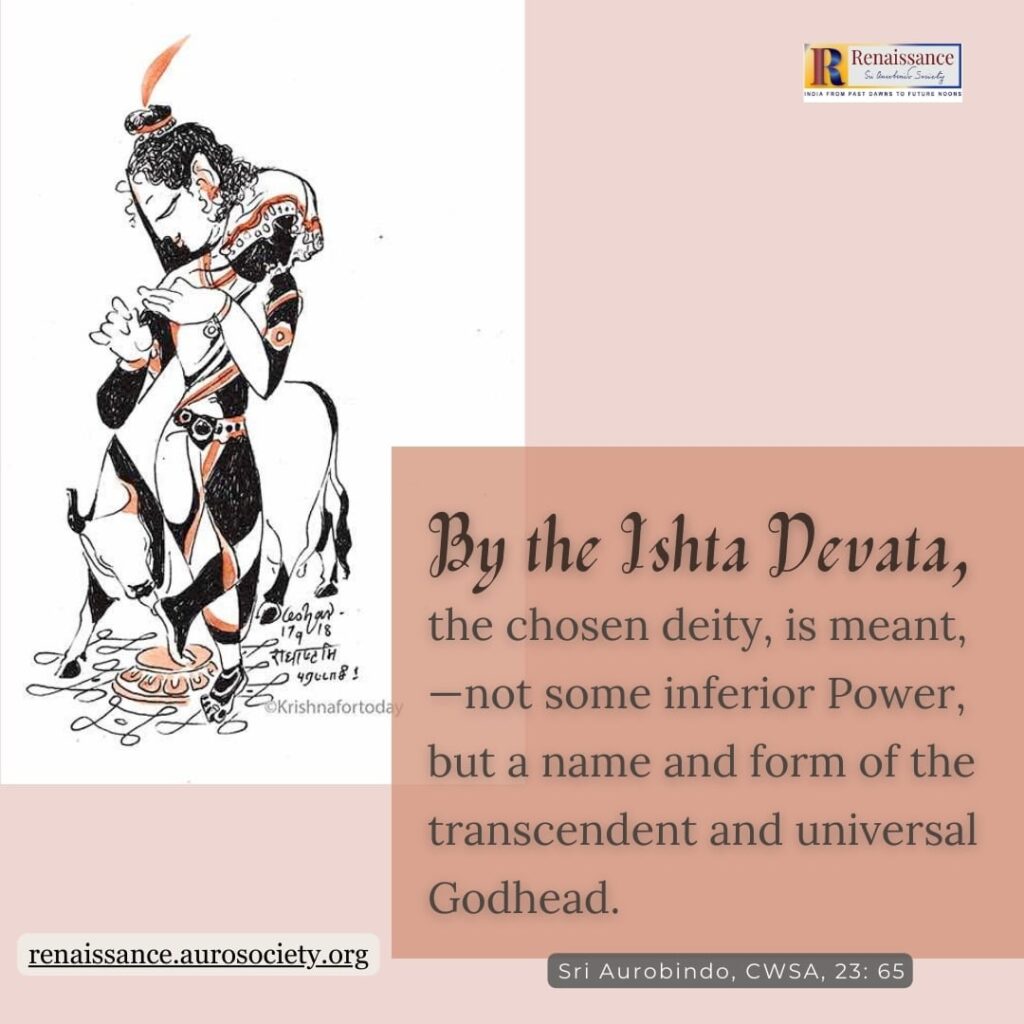
What is the drive that pushes one to become a worshipper of Siva or Vishnu or any other deity? It is not any rational understanding, a weighing of pros and cons and then a resultant conclusion that leads one to choose a path of religion or spirituality.
It is the soul’s natural call to the God, the type of being and consciousness of which it is a spark, from which it has descended. In a way, it is the secret affinity—the spiritual blood-relation as it were—that determines the choice and adherence. And it is this that we name Faith.
And the exclusiveness and violence and bitterness which attend such adherence and which go by the name of partisanship, sectarianism, fanaticism etc., are a deformation in the ignorance on the physico-vital plane of the secret loyalty to one’s source and origin.
Of course, the pattern or law is not so simple and rigid, but it gives a token or typal pattern.
For it must not be forgotten that the supreme source or the original is one and indivisible.
And in the highest integration consciousness is global and not exclusive. And the human being that attains such a status is not bound or wholly limited to one particular formation. Its personality is based on the truth of impersonality. And yet the two can go together. An individual can be impersonal in consciousness and yet personal in becoming and true to type.
The number of gods depends on the level of consciousness on which we stand.
On this material plane there are as many gods as there are bodies or individual forms (ādhāra). And on the supreme height there is only one God without a second. In between there are gradations of types and sub-types whose number and function vary according to the aspect of consciousness that reveals itself.
~ Design: Beloo Mehra

